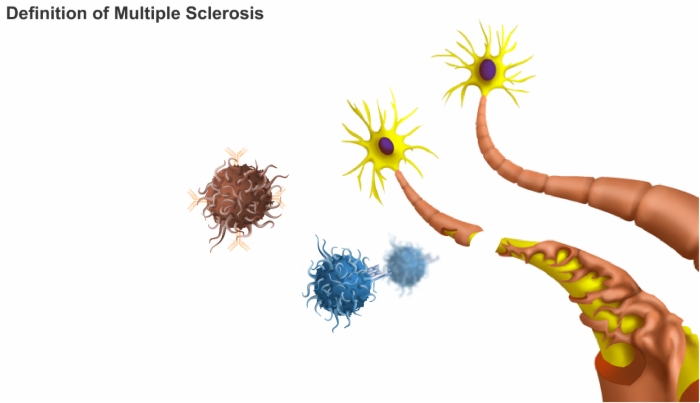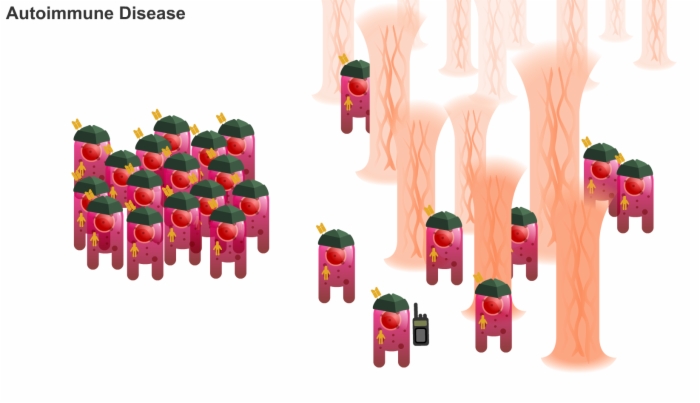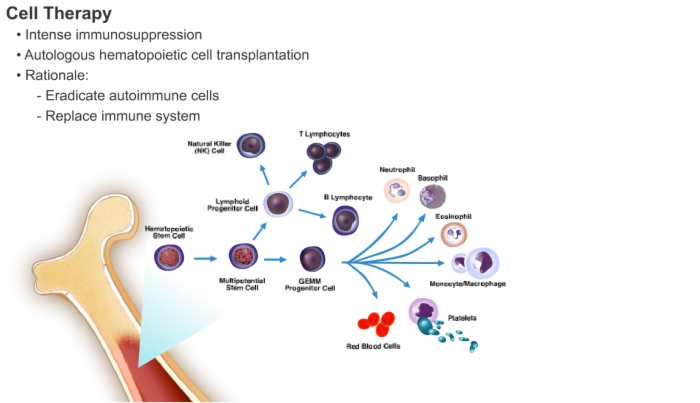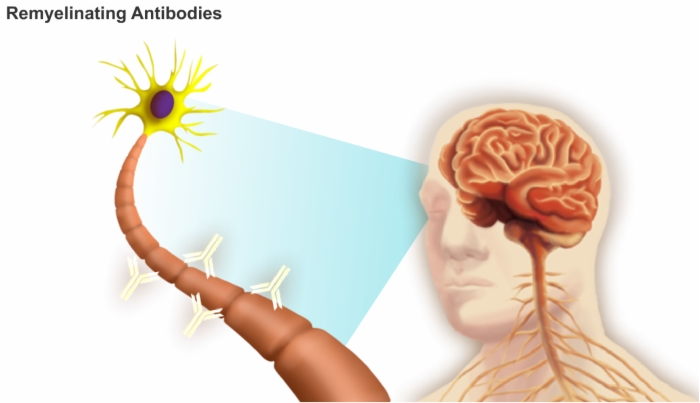SMi Source lesson Multiple Sclerosis: Gaining Knowledge on Immunology has the following microlearning topics
1. Disease Overview


2. Pathophysiology


3. Current Therapies


4. Additional concepts in MS Therapy


Lesson Multiple Sclerosis: Gaining Knowledge on Immunology teaches these concepts
Definition
Prognosis
Clinical Presentation
Patient Descriptions
Progression
Epidemiology
Etiology
Relapses
Variability
Classification
Lesson Multiple Sclerosis: Gaining Knowledge on Immunology addresses these key points
Multiple sclerosis refers to the numerous areas of scarring that result from demyelination, or destruction of the myelin sheath which surrounds nerves.
MS is characterized by demyelination, there can also be nerve damage via partial axonal loss.
MS - thought to be an autoimmune disease. Autoreactive T cells and autoantibodies are found in the circulation and cerebrospinal fluid of patients with MS.
Course of MS varies greatly from each individual and it is difficult to predict prognosis.
Rollover: Prognostic Indicators
EDSS – Expanded Disability Scoring Scale
EDSS – widely used rating system based on objective neurological examination.
EDSS – accesses clinical deficits in various functional systems of the central nervous system which control bodily functions.
EDSS – 20 scoring levels from 0 to 10, each point after 1 is divided into half points. 0 = normal neurological exam, 10 = death due to MS.
Most people with multiple sclerosis have periods of good health, or remissions, alternating with periods of worsening symptoms, or relapses.
Early symptoms of MS, such as sensory symptoms, fatigue and pain, can be initially misdiagnosed.
The symptoms may be present for some time before the disease is identified.
Neurological Descriptions
- Numbness
- Weakness
- Tremors
The progression is unpredictable, varies from patient to patient, and symptoms may vary greatly within a given patient over time.
The fluctuating symptoms result from damage to myelin sheaths and nerves, followed by repair or compensation, followed by more damage.
MS - prevalent among young adults.
About 400,000 people in the US have MS, mostly young adults. Worldwide, estimated as many as 2.5 million MS patients.
Cause is still unknown, but environmental, infectious and genetic factors are believed to interact to induce disease development.
Common clinical course of MS characterized by relapses with clinical symptoms and dysfunction.
Pattern of relapse, remission, recurrence and/or progression is a key feature of all forms of MS.
Relapses vary considerably with regard to: the anatomical sites affected; the frequency of attacks; the onset, such as sudden or sub-acute; the duration; the severity; and the quality of remission.
Classified according to pattern of relapses and remissions and the progressive worsening of symptoms over time.
Lesson Multiple Sclerosis: Gaining Knowledge on Immunology is built from these main references. Log into SMi Source for a complete list and details.
Lassmann H. Models of Multiple Sclerosis: New Insights into Pathophysiology and Repair. Curr Opin Neuro. 2008;21:242-247.
Merck Manuals. Multiple Sclerosis (MS).
van den Noort S. Signs and Symptoms of Multiple Sclerosis. In: Olek MJ, ed. Multiple Sclerosis. Etiology, Diagnosis, and New Treatment Strategies. United States: Humana Press, Inc; 2005:1-14.
Birnbaum G. Making the Diagnosis of Multiple Sclerosis. In: Freedman MS, ed. Advances in Neurology, Volume 98, Multiple Sclerosis and Demyelinating Diseases. Philadelphia, PA: Lippincott Williams & Wilkins; 2006:111-124.
Waxman SG, Craner MJ, Black JA. Na+ channel expression along axons in multiple sclerosis and its models. Trends Pharmacol Sci. 2004; 25(11):584-591.
Lazoff M. Multiple Sclerosis (Updated Mar 3, 2008). eMedicine from WebMD. Available at: http://emedicine.medscape.com/article/793013-overview. Accessed on January 12, 2009.
National MS Society Fact Sheet. Available at: http://www.nationalmssociety.org/chapters/MNM/volunteer/programs/movement-ambassadors-home/move-it-toolkit/Pressroom/Factsheetmultiplesclerosis/index.aspx.
Rosati G. The Prevalence of Multiple Sclerosis in the World: An Update. Neurol Sci. 2001;22(2):117-139.
Alonso A and Hernán MA. Temporal Trends in the Incidence of Multiple Sclerosis: A Systemic Review. Neurology. 2008;71(2):129-135.
Brissaud O, Palin K, Chateil JF, Pedespan JM. Multiple Sclerosis: Pathogenesis and Manifestations in Children. Arch Pediatr. 2001;8(9):969-978.
Miller DH, Leary SM. Primary-Progressive Multiple Sclerosis. Lancet Neurol. 2007;6(10):903-912.
Ebers GC. Environmental Factors and Multiple Sclerosis. Lancet Neurol. 2008;7:268-277.
Pyrse-Phillips W, Sloka S. Etiopathogenesis and Epidemiology: Clues to Etiology. In: Cook SD, ed. Handbook of Multiple Sclerosis, 4th ed. United States: Taylor & Francis Group, LLC; 2006:1-39.
Warren S, et. al. Mortality Rates for Multiple Sclerosis (MS) Worldwide: Geographic and Temporal Trends. In: Columbus FH, ed. Progress in Multiple Sclerosis Research. Hauppauge, NY: Nova Publishers; 2005:1-26.
Ragonese P, Aridon G, Salemi G, D’Amelio M, Savettieri G. Mortality in Multiple Sclerosis: A Review. European Journal of Neurology, 2008;15:123-127.
Campagnolo DI, Vollmer TL. Multiple Sclerosis (Updated Oct 4, 2006). eMedicine from WebMD.
Demetriou M. Multiple Sclerosis, Genetics, and Autoimmunity. In: Olek MJ, ed. Multiple Sclerosis. Etiology, Diagnosis, and New Treatment Strategies. United States: Humana Press, Inc; 2005:103-112.
Olek MJ. Differential Diagnosis, Clinical Features, and Prognosis of Multiple Sclerosis. In: Olek MJ, ed. Multiple Sclerosis. Etiology, Diagnosis, and New Treatment Strategies. United States: Humana Press, Inc.; 2005:15-53.
Vyshkina T, Kalman B. Autoantibodies and Neurodegeneration in Multiple Sclerosis. Laboratory Investigation. 2008;88:796-807.
Oksenberg JR, Baranzimi SE, Hauser SL. Biological Concepts of Multiple Sclerosis Pathogenesis and Relationship to Treatment. In: Cohen JA, Rudick RA, eds. Multiple Sclerosis Therapeutics, 3rd ed. United Kingdom: Informa UK Ltd; 2007:23-44.
Deshpande R, et al. The Natural History of Multiple Sclerosis. In: Freedman MS, ed. Advances in Neurology, Volume 98, Multiple Sclerosis and Demyelinating Diseases. Philadelphia, PA: Lippincott Williams & Wilkins; 2006:1-15.
Lesson Multiple Sclerosis: Gaining Knowledge on Immunology introduces and defines these terms
Multiple sclerosis, MS - a chronic inflammatory disease of the central nervous system which leads to numerous lesions of the white and gray matter.
EDSS – Expanded Disability Scoring Scale
Oligodendrocytes - cells that produce myelin.